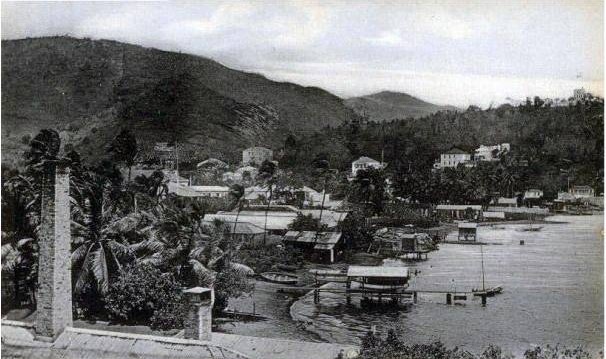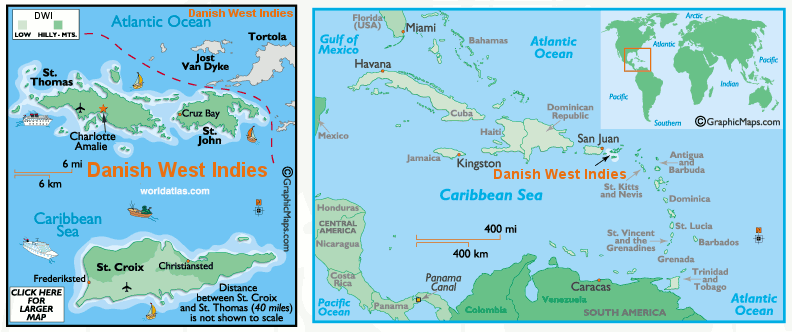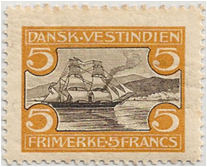ALBUM – View my Danish West Indies album
Fast Facts
Region: Caribbean
Group: Danish Colonies in the Caribbean
Classification: Colony (Denmark)
Prior Regime: Indigenous peoples
Key Dates:
1672 – First Danish settlement on St. Thomas
1683 – Expansion to St. John
1733 – St. Croix purchased from the French West Indies Company
1754 – Sold to Danish King, becomes a Royal colony of Denmark
1905 – Currency changed from daler (cents) to the franc (bits)
1917, Jan 17 – Islands sold to United States
1917, Mar 31 – DWI officially became the U.S. Virgin Islands
Following Regime: United States
Scott Catalogue: (Danish West Indies) #1-58, J1-J8
Pick Catalogue: (Danish West Indies #1-20)
History

The northern country of Denmark, although not a major power, also had a colony within the region. The colony had its beginning when the Danish West India and Guinea Company settled on St. Thomas island in 1672, expanded to St. John in 1683, and later purchased St. Croix from the French West Indies Company in 1733. Despite the conflicts with the British and the usual risks from the marauding pirates, the islands were very profitable, as they grew and exported a large volume of sugar, using primarily cheap slave labor.
In 1754, as Europe was about to explode into war (the Seven Years’ War – 1756–63) King Frederick V purchased the islands, and established them as a royal Danish Colony. By the early part of the 20th century, slave labor was no longer available and the sugar industry waned in the region, as a consequence, Denmark no longer considered the colony as a profitable venture. On 17 Jan, 1917, the islands were sold to the United States for $25 million, and on March 31st, the islands became the United States Virgin Islands.

Stamps
 ALBUM
ALBUM
The first postage stamp of the Danish West Indies was issued in 1856, and was of the same coat of arms design as the stamps of Denmark. In 1874, DWI issued new “numeral” design stamps, also mirroring Danish stamps. Most were printed in two colors, with a central oval containing the value, arms and country name, surrounded by a frame of intricate scrollwork, usually printed in a different, contrasting color. Nine denominations were issued, and over the 30+ years of use, there were numerous printing runs creating many shade varieties. Also, most issues also included an “inverted frame” variety where the plate of the scrollwork frame was inverted when printed. Add various surcharge issues which were printed to account for shortages in stamps, interesting postmarks, and well sought after postal history specimens, collecting these issues are a specialist’s paradise.
In 1905, DWI changed their currency from dalers (1 daler = 100 cents) to francs (1 franc = 100 bits). With this change, the colony took the opportunity to modernize its stamp designs as it needed to issue stamps in the new currency. Two designs were issued, one depicted a silhouette of King Christian IX, and the other a beautiful image of a sailing ship in St. Thomas harbor. In 1907 and 1915, two additional designs featuring King Frederik VIII and King Christian X were issued during the monarch’s reign. In addition to the definitive stamps, DWI also issued postage due stamps, both in the pre 1905 “cents” and in the new currency after the monetary reforms. Stamps of DWI were replaced with stamps of the United States after the transfer of power in 1917.
Banknotes
In 1849, the State Treasury introduced notes in denominations of 2, 3, 5, 10, 50 and 100 dalere. The Bank of St Thomas issued notes denominated in dollars between 1837 and 1889. It is not indicated on the notes which dollar this was.In 1905, the Dansk-Vestindiske Nationalbank (Danish West Indies National Bank) introduced notes in denominations of 5, 10, 20 and 100 francs, which also bore indications of their value in Danish kroner, 3.6, 7.2, 14.4 and 72 kroner.
Links
A brief history of the Danish West Indies, 1666-1917
Danish West Indies Banknotes at ATSnotes





Hi – very nice site – – Question: what catalogue (Scott ??) do I need to determine the value of Danish West Indies and US Virgin Islands stamps.
Thanks
Depends – Scott gives you US Dollars (and is probably the best for US Virgin Islands since it is a US area). However if you are from the UK then Stanley Gibbons might be better.